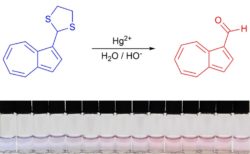
CSCT/WIRC researchers develop a sensor molecule that detects mercury in water by colour change
Picture caption: (from left to right) Dr Jannis Wenk, Dr Carlos López-Alled, Dr Simon Lewis and Professor Tony James
A CSCT alumnus has developed a molecule that detects mercury contamination in water by changing colour, allowing rural communities to easily monitor water contaminants using low-cost methods.
Globally, over 10 million people work in unregulated gold mining, where mercury is used to extract gold from ore. This leads to mercury contamination of local water sources, which poses a health threat for rural communities in many regions of the world.
Detecting mercury pollution requires special equipment and training, both of which are unavailable in rural communities. Therefore, easy-to-use sensing tools are essential to allow communities to assess the safety of their drinking water sources over time.
CSCT alumnus Dr Carlos López-Alled, graduated in 2019, has developed a molecule that changes colour if mercury is present in water. The developed molecule can be manufactured at low cost in a two-step process, and its response to mercury is rapid and sensitive enough so that the colour change can be discerned unambiguously without the need for a laboratory setting, an expert user, or a power supply. The molecule has also an excellent selectivity for mercury over other elements and molecules commonly present in drinking water.
The same method or molecular platform can be customised to detect other water contaminants, as researchers in the CSCT and the Water Innovation and Research Centre (WIRC) have shown in a series of publications. Examples include fluoride (1, 2) and nitrite. The platform has also been employed to detect cytotoxic reactive oxygen and nitrogen species.

Colour change of the new colorimetric chemodosimeter in the presence of mercury(II) (50–700 micromolar)
Dr Jannis Wenk, from the supervisory team, said: “I am very excited about our neat modular approach using a simple but colourful molecule that can be easily adapted to interact with specific water contaminants by inducing a change in its colour. This fruitful interdisciplinary collaboration between organic chemists and water scientists has enabled us to create a versatile analytical tool that does not only simplify the analysis of mercury but can be also applied to a range of other drinking water contaminants.”
The research team are currently working to increase the range of applications of the method, including detecting a wider range of difficult-to-detect drinking water contaminants, environmental sampling for ocean research, and simplifying handling by immobilising the molecule on paper and in gels.
The results of this collaborative research between research groups at Bath in Chemistry (Simon Lewis and Tony James) and Chemical Engineering (Jannis Wenk) were published recently in the RSC journal Analyst.







